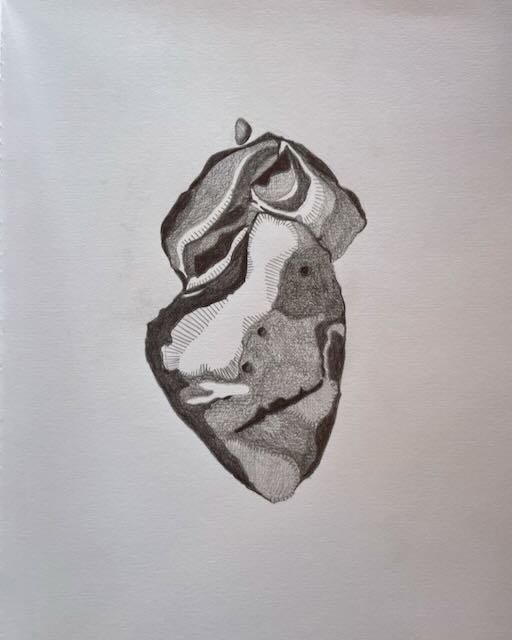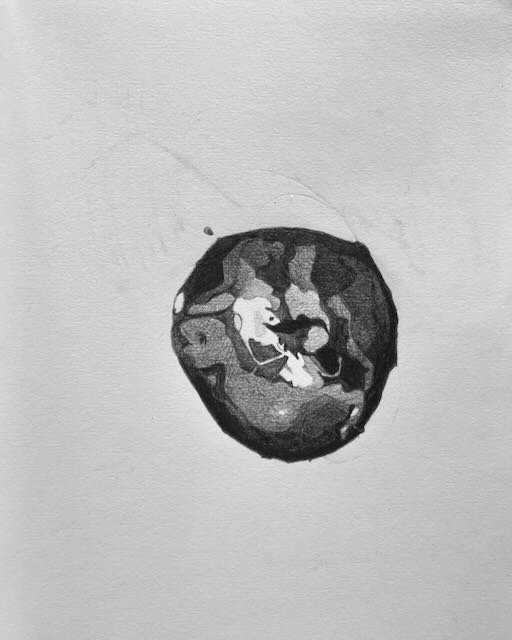rESIDENCY: Raglan, NZ
22 January - 1 February 2025
Tracing the Stones
The Sea and the Stones
…in their resting place
Raglan is characterised by a coastline that is renowned in the surfing community for its exceptional left hand break. My initial focus during this residency was to place myself by the sea and observe the famous waves of Manu and Whale Bay. I took my camera and sound recorder with me but aside from that had no particular agenda. I wanted to be open to what was present and happening. What became evident, aside from the dramatic wild sea and black sand, was the vast presence of volcanic rock.
In their resting place (for now) on the black sand, pushed and pulled from all and every direction, the basalt stones illustrated steadfastness in spite of the shifting sands and battering waves. A volcanic eruption on Mt Karioi, 2.5 million years ago, was where and when these stones began their journey before settling at a place where land meets the sea.
One stone, captured in the film below, is centrally placed, not moving. Any alteration or changes in the film come from the waves or the sway of the film maker. Three parts of a trilogy, rock, sea and observer, render the content of this short film, the object, the context and duration. Behind the camera, unseen, the observer stands apart, identifiable by the wobble in the recording. They (namely me) are merely framing a moment in time in order that the object and context be captured and defined. This, nevertheless, is a form of interference, as I would argue, the rock and the sea do not need the film to confirm the phenomenon of their existence.




The Gorge and the Stones
… and their journey to the sea
Te Toto Gorge
As my focus on the basalt stones increased, I began to take an interest in where the stones came from and how they shaped the landscape after the volcanic eruption 2.5 million years ago. Te Toto Gorge is a geographical scar that extends from the now extinct volcano to the sea. It was formed when a side flank of the volcano collapsed, exposing balsaltic lava embedded in the cliffs and revealed clear geological characteristics, unique to Mt Karioi.
Following the journey of the stones brought my attention to a walking track that enabled me to travel deep into the gorge. My descent on the 28th January was an adventure. The marked trail was difficult to trace, and was very steep and slippery in places. It was like walking through earths deep history. I noticed the balsalt stones and listened to the sounds of the trickling stream. I was able to experience the sensation of emersion as I entered the thick undergrowth that characterised the beginning of the trail. Once deep inside the gorge and through the thicket the enormity of the amphitheatre created by Te Toto Gorge was something to behold. Looking up towards the gorge and away from the sea, Mt Karioi loomed above.
The Volcano and the Stones
… a quest to seek their source
Mt Karioi from my residence
Climbing Mt Karioi on the 3rd of February with my sister Jo, I wanted to experience the mountain from where the basalt stones once came from. Tracing the stones history, I was able to follow the narrative of the landscape. My journey began in the present, on the beach in Raglan, and travelled back in time through the gorge and lastly to the top of Mt Karioi. I began to get a sense of the force of nature as it laid down its present form. To reach the summit, (in fact we didn’t continue to the summit but were satisfied with reaching the ‘Lookout’ of Mt Karioi), we climbed steadily for 2 hours. There were some challenging moments but it was manageable and we completed the climb there and back in one day. At times it was necessary to navigate ladders and chains to help with the steep sections of the mountain. I felt a deep sense of contentment and, although only for a short period of time, I was able to experience the mountain, its earthiness, its steepness, the sounds and vegetation. These were the immediate sensations I experienced on Mt Karioi but I could also behold and perceive its mystery and its immensity.
My experience of tracing the landscape led me to look at the works of Richard Long. I had listened to a talk recently at UWE, Bristol, (11/11/2024) where Long expressed that his 'work is about measuring himself against the world’. He brought nothing with him when he created his works in the landscape, and took nothing away. This resonated with me as my intention was to observe and to notice place, not to alter or to rearrange it. It highlighted the smallness of being in the presence of the force of nature.











